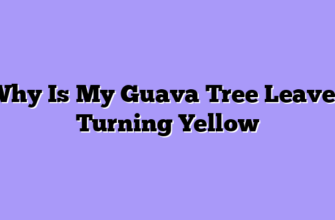Have you ever wondered about the lifespan of a fruit tree? As someone who’s spent the last two decades nurturing these remarkable plants, I can tell you that the common guava (Psidium guajava) is like that reliable friend who sticks around through thick and thin. Today, I want to share my experience with these incredible trees and answer the question that keeps popping up at farmer’s markets: “Mike, how long will my guava tree actually live?”
The Growth Journey: From Seedling to Maturity
Let me take you back to when I first started growing yellow guava, or “bayabas” as my Filipino workers affectionately call it. I remember planting my first seedling like it was yesterday – a tiny thing no taller than my coffee mug. Those early days were filled with equal parts excitement and anxiety, kind of like watching your firstborn take their first steps.

The most remarkable thing? A healthy guava tree can live anywhere from 30 to 40 years, and I’ve even heard of some specimens pushing 50! Think about that – these trees could potentially outlive your mortgage. Of course, this longevity depends heavily on care and environment, but I’ll get to that in a minute.
Here’s what the typical life stages look like:
- Seedling to juvenile (0-2 years):
- Rapid vertical growth
- Development of root system
- No fruit production yet
- Young adult (2-8 years):
- First fruit production (usually around year 4)
- Establishment of canopy
- Peak growth rate
- Mature adult (8-30+ years):
- Stable fruit production
- Slower growth rate
- Maximum size achievement
Factors Affecting Longevity
Now, here’s where things get interesting. The common guava, or peegwah as it’s known in some parts of the Caribbean, isn’t just a set-it-and-forget-it kind of tree. Think of it like a classic car – with proper maintenance, it’ll run beautifully for decades, but neglect it, and well… you get the picture.
I’ve learned through trial and error (mostly error, if I’m being honest) that several key factors determine how long these beautiful trees will grace us with their presence. Climate plays a huge role – guavas are tropical warriors, but they have their limits. I’ve seen perfectly healthy trees struggle after unexpected frost events, while others in protected spots sailed through without a scratch.
Soil quality is another crucial factor. These trees aren’t particularly picky eaters, but they do need well-draining soil with the right pH balance. I always tell new farmers that soil preparation is like laying the foundation for a house – get it right, and everything else becomes much easier.
Disease management is perhaps the most critical aspect of ensuring longevity. Just like humans need regular check-ups, guava trees need consistent monitoring for common issues like root rot or wilt disease. I’ve saved countless trees simply by catching problems early.
The Secret to Extended Life
Want to know the real secret to keeping your Psidium guajava thriving for decades? It’s all about preventive care. I’ve developed what I call my “Golden Rules of Guava Longevity” over the years, and they haven’t failed me yet.
First off, regular pruning is non-negotiable. Think of it as giving your tree a regular haircut – it might seem counterintuitive to cut away healthy growth, but trust me, it works wonders for the tree’s overall health and fruit production. I usually prune my trees twice a year, removing dead wood and shaping the canopy to allow proper air circulation.
Irrigation is another critical factor. I’ve installed a drip system throughout my orchard, ensuring each tree gets consistent moisture without overwatering. It’s like having a perfectly calibrated drinking fountain for each tree – they get exactly what they need, when they need it.
Here’s a surprising fact: companion planting can significantly impact a guava tree’s lifespan. I’ve found that planting certain herbs and flowers around my trees not only helps with pest control but also seems to promote overall tree health. It’s like creating a little supportive community for each tree.
The Long-Term Perspective
Looking back at my decades-long journey with these remarkable trees, I can’t help but feel a sense of pride. Some of my original guava trees, planted when I first started farming, are still producing fruit today. They’re like old friends who’ve been with me through every season, every challenge, and every triumph.
I’ve watched young saplings grow into robust trees that now provide shade for my grandchildren when they visit the farm. It’s amazing to think that these trees might still be bearing fruit long after I’ve hung up my farming boots. That’s the real beauty of growing guava – you’re not just planting a tree, you’re creating a legacy.
The question of how long guava trees live isn’t just about numbers – it’s about understanding that with proper care and attention, these remarkable plants can become multi-generational treasures. They’re not just fruit producers; they’re time capsules, carrying stories and memories through the years.
Remember: A guava tree’s lifespan isn’t just about surviving – it’s about thriving. With proper care, regular maintenance, and a little bit of love, these amazing trees can be productive members of your garden or orchard for decades to come.








